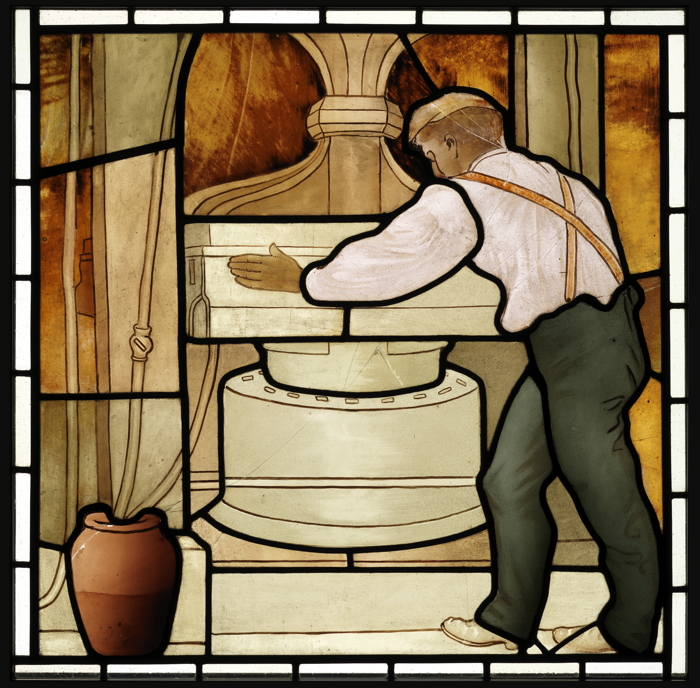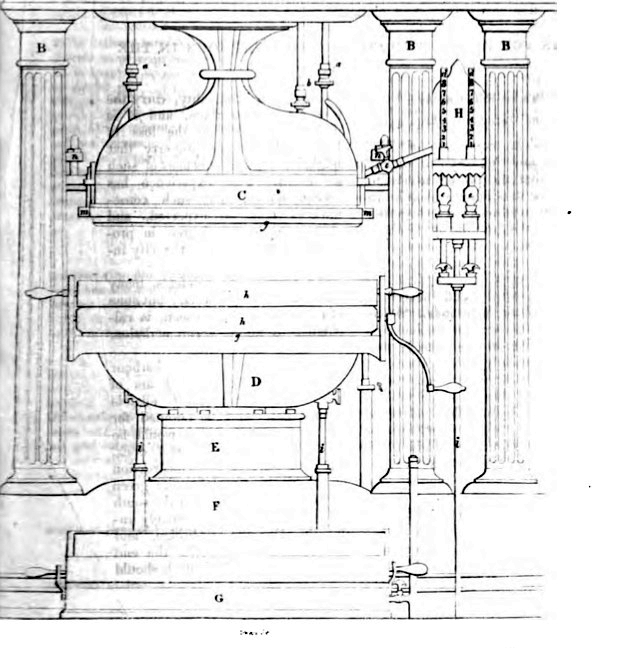Maryhill Stained Glass: 130 year old mystery solved at last!
The mystery of the unknown worker has been solved.
A stunning series of 20 stained glass panels were commissioned for the Maryhill Burgh Halls in 1878, featuring the many varied trades and industries of the area.
Most are easily identifiable images such as a gas worker, iron moulder, joiner or boat-builder.
But one of the panels has remained a mystery – and with all the original paperwork having been long since lost, there was no easy way to figure out exactly what sort of job the ‘Unknown Worker’ was doing.
Years of research had been unable to positively identify it – and suggestions varied from a metal casting process, a brewing process or even a steam laundry.

This long-standing mystery has finally been solved by Glaswegian Michael Meighan, who has been researching for his new book ‘Glaswegians with a Flourish’. Said Michael:
“I was aware of the Maryhill stained glass puzzle, and I was as intrigued as anyone. While I was investigating the role of the Mechanics Institute in Glasgow – which was attended by Scotland’s first oil tycoon James ‘Paraffin’ Young - I came across the Institute’s ‘Mechanics Magazine’ published in 1824 and held by the National Library of Scotland.
On the front page of one of the issues was a drawing of a press almost exactly like the equipment being used in the stained glass window.
Imagine my growing interest as I started reading a ‘Description of the Great Bandana Gallery in the Turkey Red factory of Messrs Monteith & Co. at Glasgow’.

This described in detail the process of using a hydrostatic press to impregnate and pattern cotton cloth with Turkey red dye. In this case this factory contained presses which produced bandanas for foreign markets including the iconic scarves worn by the American cowboys!
Turkey red dyeing was originally brought to Scotland from France, and became a massively important industry in the West of Scotland in the 1800’s.
Besides cowboy bandanas, the British Redcoats were dyed with Turkey red, as well as beautifully patterned cloths which were exported throughout the world.
The dyeing process was revolutionary as it allowed whole cloths to be dyed, rather than the threads from which they were made, shortening the process considerably. One factory that had 16 presses of the type shown was able to produce 1600 pieces of 12 yards each in just ten hours.”
Heritage Development Officer for the Trust, Gordon Barr, said:
“Just when I started to think we’d never know for sure what was going on in this panel, I got a phone call from Michael out of the blue! We’re delighted to have the mystery solved, and fill in the last blank.
But just as one puzzle is solved, it also reveals more questions to be asked – we don’t know which company in the Maryhill area might have been using this process at the time the panels were commissioned – so there’s still more to find out to keep us busy!”
Thanks to a partnership with Glasgow Museums, who have had the glass in safe keeping for nearly 50 years, the restoration will also see a significant collection of the original stained glass windows, conserved and returned to the Burgh Halls for display once the building is re-opened later this year.
In addition, the Trust has recently commissioned 10 new stained glass “Windows of Today” which will depict life in Maryhill as it is now.
Notes to Journalists:
This news release is issued by Maryhill Burgh Halls Trust www.maryhillburghhalls.org.uk
Further information is available from Hunter Reid, Project Co-ordinator and Company Secretary on 07808 739627 or Dr Gordon Barr, Heritage Development Officer, 0794 081 5202 at any time email: press@mbht.org.uk
Michael Meighan is the author of ‘Glasgow Smells’ and ‘Glasgow Smells Better’. ‘Glaswegians with a Flourish’ is due to be published in May and he is currently working on a book on Scottish Industry in which Turkey Red will feature.
Contact via email: Michael_meighan1@hotmail.com
Phone 0131 447 9461 or 0776 8282 155
About the Project
The 133 year old building is undergoing a £9.2 million restoration project, which will breathe new life into the iconic Halls, save them for the community, create a thriving centre for business, and make the place once again the focus and beating heart of Maryhill. Maryhill Burgh Halls Trust raised this remarkable sum to secure a bright future for the treasured Halls and in so doing recapture the splendor of one of the city's best loved buildings. The restoration work began in November 2009 and is scheduled for completion later this year.
In November 2010, the project was awarded a prize as Best contribution to Urban Regeneration in Scotland through the use of European Structural Funds at the European Structural Funds Best Practice Awards.
Maryhill Burgh Halls were the seat of municipal government in the days before Maryhill was a part of Glasgow. Built in 1878 and designed by renowned architect Duncan McNaughtan, they have lain derelict for the past eight years and are listed on the Buildings at Risk register. Once restored, the Halls will include a modern public hall, cafe, 11 offices, a commercial and a community recording studio, a nursery, meeting rooms and courtyard garden. Around 6 years of hard work has been put into developing proposals for the project. The Board of the Trust, which comprises local people and representatives from partners Maryhill Housing Association, Cube Housing Association and Glasgow City Council, has worked tirelessly to deliver the restoration.
The contractor for the project Graham Construction has secured employment opportunities within the local community by creating three apprenticeships in joinery to work on the Halls restoration.
Funding for the Maryhill Burgh Halls project has come from:
European Regional Development Funding £1.279m
Scottish Government City Growth Fund Phases 1 and 2 £1.25m
Heritage Lottery Fund £990,000
Big Lottery - Growing Community Assets Fund £980,910
Glasgow City Council Better Glasgow Fund £1.02m
Glasgow City Council Vacant and Derelict Land Fund £650,000
Scottish Government Town Centre Regeneration Fund £1.8m
Historic Scotland £500,000
Scottish Government Wider Role Fund £750,000
The Robertson Trust £28,000
Everyone who is interested in following the development of the project through to completion can view progress and comment on the project on the Trust's Website at www.maryhillburghhalls.org.uk
